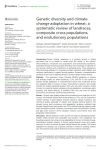Babalola K.O., Monacelli N., Gozzi M., Ceccarelli S., Folloni S., Galaverna G. (2025). Genetic diversity and climate change adaptation in wheat: a systematic review of landraces, composite cross populations, and evolutionary populations. Frontiers in Sustainable Food Systems, 01/01/2025, vol. 9, p. 3504922.
https://doi.org/10.3389/fsufs.2025.1504922
https://doi.org/10.3389/fsufs.2025.1504922
| Titre : | Genetic diversity and climate change adaptation in wheat: a systematic review of landraces, composite cross populations, and evolutionary populations (2025) |
| Auteurs : | K.O. Babalola ; N. Monacelli ; M. Gozzi ; S. Ceccarelli ; S. Folloni ; G. Galaverna |
| Type de document : | Article |
| Dans : | Frontiers in Sustainable Food Systems (vol. 9, 2025) |
| Article en page(s) : | p. 3504922 |
| Langues : | Anglais |
| Langues du résumé : | Anglais |
| Catégories : |
Catégories principales 07 - ENVIRONNEMENT ; 7.6 - Changement ClimatiqueThésaurus IAMM CHANGEMENT CLIMATIQUE ; CEREALICULTURE ; CEREALE ; BLE ; VARIETE ; VARIETE INDIGENE ; ADAPTATION AU CHANGEMENT |
| Résumé : |
Introduction - Climate change adaptation is a growing priority in global agriculture due to its threats to cereal crops like wheat. In this context, wheat landraces, composite cross populations, and evolutionary populations, developed through evolutionary plant breeding, are increasingly recognized for their genetic diversity and contributions to agrobiodiversity. These populations offer promising pathways for improving drought tolerance, yield stability, and resilience, particularly in organic farming systems. However, a comprehensive synthesis of their role in adapting wheat to climate change remains limited.
Methods - This systematic review followed PRISMA guidelines to identify and evaluate studies on wheat landraces, CCPs, and EPs in the context of climate change adaptation. A comprehensive search was conducted across five databases (Web of Science, Scopus, ScienceDirect, iScience, and Google Scholar) for studies published between 2011 and July 2024. Inclusion criteria focused on empirical studies addressing climate adaptation, evolutionary plant breeding, and wheat diversity. A modified CASP tool was used for quality assessment, and thematic synthesis was performed. Results - Thirteen high-quality studies were included from an initial pool of 325 records. The findings indicate that wheat landraces, CCPs, and EPs outperform modern varieties in yield stability, drought tolerance, disease resistance, and nutritional quality, especially in organic and marginal farming systems. EPs showed strong yield consistency and adaptability; landraces exhibited high drought tolerance and grain quality; and CCPs offered buffering capacity under biotic and abiotic stresses. However, most studies were concentrated in Europe, and gaps were found in farmer adoption research, post-harvest traits, and geographic representation. Discussion - Wheat landraces, CCPs, and EPs are vital for developing climate-resilient wheat varieties and sustainable food systems. Their integration into breeding programs can enhance crop adaptability in the face of climate change. Nonetheless, broader research in diverse agroecological zones and greater attention to socio-economic and post-harvest factors are needed. This review highlights the strategic role of genetic diversity in wheat for building resilient agri-food systems and outlines directions for future research and policy. |
| Cote : | En ligne |
| URL / DOI : | https://doi.org/10.3389/fsufs.2025.1504922 |







